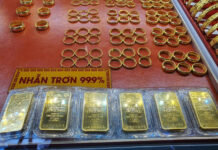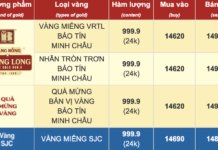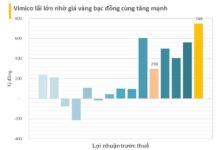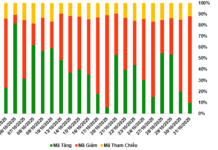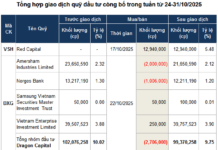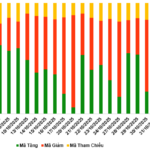No Need to Intervene with Foreign Exchange
On April 17, the State Bank of Vietnam announced the central exchange rate of the USD as 24,231 VND, an increase of 90 VND compared to yesterday. With a 5% margin from the central exchange rate, commercial banks are allowed to buy and sell USD within the range of 23,019 – 25,442 VND.
This morning, banks continued to raise the USD price close to the allowed ceiling. In total, the US dollar has become more expensive by 260 VND since the beginning of the week, equivalent to 1%.
Specifically, at Vietcombank, USD buying and selling increased to 25,070 – 25,440 VND, up 92 VND compared to yesterday. Eximbank also adjusted its USD price to 25,040 – 25,440 VND. BIDV raised its exchange rate close to the ceiling, buying and selling at 25,130 – 25,440 VND.
Thus, since the beginning of this year, each USD in the bank has increased by more than 1,000 VND, equivalent to nearly 4.2%.
Meanwhile, in the free market, the buying and selling prices of the greenback are hovering around 25,500 – 25,650 VND.

Since the beginning of this year, each USD in the bank has increased by more than 1,000 VND, equivalent to nearly 4.2%
The exchange rate is heating up day by day, however, according to Mr. Nguyen Ba Hung, Chief Economist of the Asian Development Bank’s (ADB) Resident Mission in Vietnam, the current exchange rate is in line with the general trend and within the margin of the State Bank, so it is not yet necessary to use foreign exchange to intervene.
The ADB expert said that in managing the exchange rate, it is necessary to have a long-term perspective. In Vietnam, the exchange rate experienced a period of relatively large fluctuations at the end of 2022, when it exceeded the 3% margin allowed by the State Bank. However, the State Bank then took the initiative to widen the margin to 5%, so that Vietnam’s exchange rate fluctuations were within the general fluctuations of the USD in the world market.
According to Mr. Hung, the USD Index (DXY) itself, which measures the movement of the greenback against six major currencies (EUR, JPY, GBP, CAD, SEK, CHF), has increased by about 3% since the beginning of the year and is currently hovering around 106 points (the highest point at the end of 2022 was 107). Therefore, “not taking into account other factors, the pressure leading to the increase of USD against VND primarily comes from the USD itself”, said the ADB expert.
At the same time, he affirmed that the exchange rate fluctuations in the recent period are still within the policy management framework set by the State Bank. In addition, the exchange rate fluctuations in the recent past are related to historical and seasonal factors in the Vietnamese market. “Usually, in the first quarter of the year, demand for foreign currency increases, as a result of the end of the fiscal year and people’s needs such as investment and foreign currency storage. These are natural market movements,” said Mr. Hung.
The ADB Chief Economist expressed the view that the current exchange rate developments are in line with the general trend and within the margin of the State Bank, so it is not yet necessary to use foreign exchange to intervene. “ In my opinion, it is necessary to recognize that exchange rate fluctuations are quite normal. Exchange rate policy cannot stand still, because it does not depend entirely on one economy but on the general developments of the regional and global economy,” said the ADB expert.
Balancing Gold Management Measures
Not only the exchange rate, but also gold prices have recently increased sharply. Both of these factors have significant impacts on Vietnam’s macroeconomic economy. Analyzing gold prices and gold market management , the ADB Chief Economist said that, in the world, gold is often used as a risk management tool when there are political fluctuations. In the recent past, there have been many fluctuations in the world, so central banks have taken the initiative to buy gold. This also shows the central banks’ response to those political fluctuations. “In fact, in a favorable geopolitical context, demand for gold will be low. In contrast, when geopolitics are tense, demand for gold will be high,” said Mr. Hung.
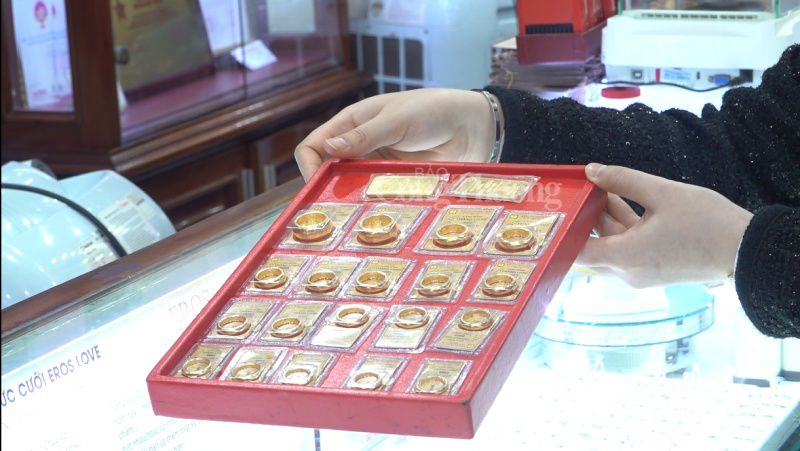
Gold market in the country fluctuates mainly due to supply and demand
As for the domestic gold market, according to the ADB expert, fluctuations are mainly due to supply and demand, but the psychological factor of the market is also quite specific.
Mr. Hung analyzed: Firstly, from the perspective of supply and demand management, the current domestic supply has certain limitations. Therefore, when there are fluctuations in sentiment or other investment instruments are not attractive, gold becomes an investment tool, so the gold price increases.
Secondly, from the perspective of state management of gold, gold is also similar to foreign currency and is also a basic commodity, but the approach to the gold market is still administrative. ; Therefore, when there are fluctuations in supply and demand, the control method is still administrative.
“The ADB did not participate in the process of revising Decree 24 on the management of gold trading activities. However, we believe that, in principle, if a combined approach is taken, balancing state management measures from various perspectives, the gold market will operate more effectively. Specifically, combine managing gold as a monetary instrument and a financial product for investment while also a commodity with supply – demand,” Mr. Hung suggested.






